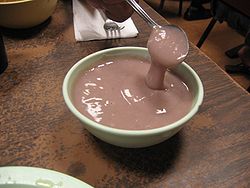 A bowl of poi. | |
| Country or region | Solomon Islands |
|---|---|
| National dish | Poi |
| National drink | Kava |
| Part of a series on the |
| Culture of Solomon Islands |
|---|
 |
| People |
| Languages |
| Cuisine |
| Religion |
| Music |
| Sport |
Cuisine of the Solomon Islands has developed over 5,000 years of inhabitation and external influences. From the Spanish, the islands received cattle; from the Asians and Indians, spices, exotic vegetables and fruit.
Contents
The islands were later colonized by the English, who left their own culinary mark. The main occupations of the locals are fishing and agriculture, so fish, coconuts, cassava, sweet potatoes and a variety of fruits and vegetables figure into the local cuisine.